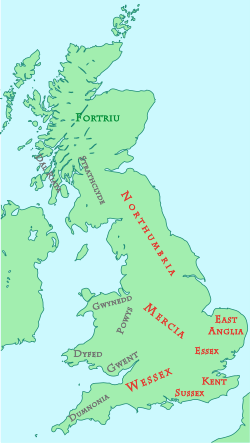
Back مملكة ساسكس Arabic مملكة ساسكس ARZ Reinu de Sussex AST Сасэкс BE-X-OLD Rouantelezh Sussex Breton Regne de Sussex Catalan Sussex (království) Czech Kongeriget Sussex Danish Königreich Sussex German Sussex (regno) Esperanto
Kingdom of the South Saxons | |||||||||||
|---|---|---|---|---|---|---|---|---|---|---|---|
| c. 477–860 | |||||||||||
 Britain around AD 800 | |||||||||||
| Status | Independent kingdom (477–686, 715–771, 796–827) Client state of Wessex (686–715, 827–860) Client state of Mercia (771–796) | ||||||||||
| Official languages | West Saxon Old English | ||||||||||
| Religion | Paganism (before 7th century) Christianity (after 7th century) | ||||||||||
| Government | Monarchy | ||||||||||
| Monarchs (see full list) | |||||||||||
• 477–491 or later | Ælle | ||||||||||
| Æðelwealh | |||||||||||
| Legislature | Witenagemot | ||||||||||
| Historical era | Heptarchy | ||||||||||
• Established | c. 477[a] | ||||||||||
• Subject to Wessex | c. 686 to c. 715 | ||||||||||
• Subject to Mercia | 771 to c. 796 | ||||||||||
• Subject to Wessex | From c. 827[2] | ||||||||||
• Full integration into crown of Wessex | 860[3][4] | ||||||||||
| Population | |||||||||||
• 450 | 25,000[5] | ||||||||||
• 1100 | 35,000[5] | ||||||||||
| Currency | Sceat | ||||||||||
| |||||||||||
| Today part of | United Kingdom ∟ South East England | ||||||||||
The Kingdom of the South Saxons, today referred to as the Kingdom of Sussex (/ˈsʌsɪks/; from Middle English: Suth-sæxe, in turn from Old English: Suth-Seaxe or Sūþseaxna rīce, meaning "(land or people of/Kingdom of) the South Saxons"), was one of the seven traditional kingdoms of the Heptarchy of Anglo-Saxon England.[6] On the south coast of the island of Great Britain, it was originally a sixth-century Saxon colony and later an independent kingdom. The kingdom remains one of the least known of the Anglo-Saxon polities, with no surviving king-list, several local rulers and less centralisation than other Anglo-Saxon kingdoms.[7] The South Saxons were ruled by the kings of Sussex until the country was annexed by Wessex, probably in 827, in the aftermath of the Battle of Ellendun. In 860 Sussex was ruled by the kings of Wessex, and by 927 all remaining Anglo-Saxon kingdoms were ruled by them as part of the new kingdom of England.
The foundation legend of the kingdom of Sussex is that in 477 Ælle and his three sons arrived in three ships, conquering what is now Sussex. Ælle became overlord, or Bretwalda, over the other Anglo-Saxon kingdoms south of the Humber. Historians are divided over whether or not Ælle really existed; however archaeological evidence supports the view that a short-lived expansion of South Saxon authority as far as the Midlands may have taken place in the 5th century.[8]
For much of the 7th and 8th centuries, Sussex suffered invasion attempts by the kingdom of Wessex to its west. King Æðelwealh formed an alliance with Christian Mercia against Wessex, becoming Sussex's first Christian king. With support from St Wilfrid, Sussex became the last major Anglo-Saxon kingdom to become Christian. South Saxon and Mercian forces took control of what are now east Hampshire and the Isle of Wight. Cædwalla of Wessex killed Æðelwealh and "ravaged Sussex by fierce slaughter and devastation". The South Saxons forced Cædwalla from Sussex and were able to lead a campaign into Kent, replacing its king. At that time Sussex could have re-emerged into a regional power.[9][10] Shortly afterwards, Cædwalla returned to Sussex, killing its king and putting its people into what Bede called "a worse state of slavery".[11] The South Saxon clergy were put under the control of West Saxon Winchester.[11] Only around 715 was Eadberht of Selsey made the first bishop of the South Saxons, after which further invasion attempts from Wessex ensued.
Following a period of rule by King Offa of Mercia, Sussex regained its independence but was annexed by Wessex around 827 and was fully absorbed into the kingdom of Wessex in 860.[3][4]
- ^ Brandon 2006, p. 68
- ^ Cite error: The named reference
EcgODNBwas invoked but never defined (see the help page). - ^ a b Cite error: The named reference
Higham 2013 245was invoked but never defined (see the help page). - ^ a b Cite error: The named reference
Kirby 2000 169was invoked but never defined (see the help page). - ^ a b Cite error: The named reference
Brandon 1978 225was invoked but never defined (see the help page). - ^ The Latin name was used, for instance, by William of Malmesbury.
- ^ Cite error: The named reference
Semple 2013 25was invoked but never defined (see the help page). - ^ Myres 1989, pp. 136–140
- ^ Cite error: The named reference
Kirby114was invoked but never defined (see the help page). - ^ Cite error: The named reference
Venning45-46was invoked but never defined (see the help page). - ^ a b Brandon 1978, p. 32
Cite error: There are <ref group=lower-alpha> tags or {{efn}} templates on this page, but the references will not show without a {{reflist|group=lower-alpha}} template or {{notelist}} template (see the help page).